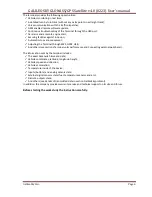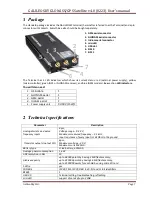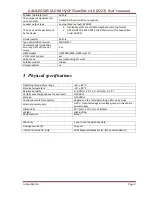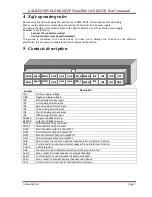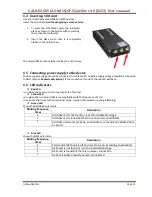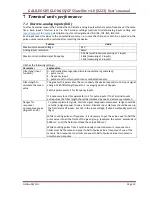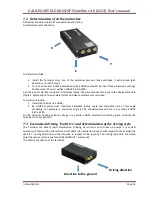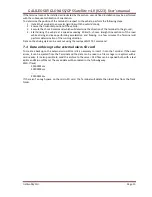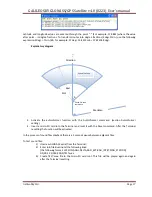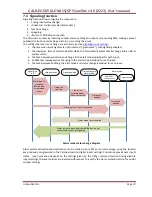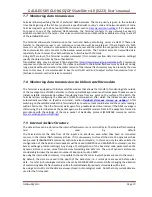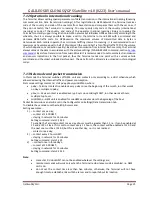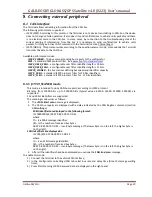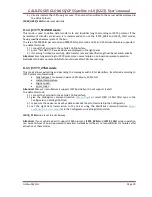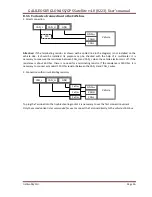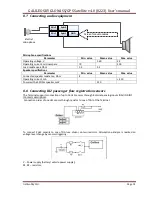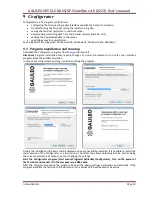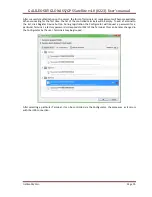
GALILEOSKY GLONASS/GPS Satellite v4.0 (0223) User’s manual
GalileoSky Ltd.
Page 20
7.10
Operation with two SIM-cards
The Terminal has 2 slots for installation of SIM-cards. Only one SIM-card can be active and support
registration in GSM-network at the same time. Each SIM-card has its own APN. If
a
PIN code is used, it must
be the same for both SIM-cards. The Terminal supports the following algorithm of SIM-card operation:
1.
Only one SIM0 card is always active.
2.
Automatic switching to the other card, if the data cannot be sent to the server within 9 minutes.
Switching occurs in cycles, i.e. first SIM0 is used, then SIM1, and after this SIM0 again.
3.
Switching between SIM-cards according to the list of preferred GSM-networks. If the terminal finds
the availability of one of the specified GSM-networks, switching to the correspondent SIM-card
occurs. If networks, specified for SIM0 and SIM1, are available at the same time, the preference is
given to SIM0.
The second algorithm is always used for remote firmware updating; the Terminal attempts to get the
connection to the server with firmware through SIM 0, and if it fails - through SIM 1.
7.11
GPRS traffic costs optimization
GPRS-traffic costs decrease by online monitoring may be reached by following these advices:
1. Turn off the transmission of unused data, for example temperature, acceleration, analog and digital
inputs values, which have no connected sensors. It can be made in the Configurator on Settings/Protocol
tab or by MainPack and HeadPack commands (section Server exchange protocol settings).
2. Increase points record period. It can be made in the Configurator on Settings/Track tab or by WrPeriod
command (section Track parameters settings).
3. Increase turning angle at which the device records a point, and distance at exceed of which the point is
recorded. It can be made in the Configurator on Settings/Tracks tab or by Turning command (section Track
parameters settings).
4. Find out the time of disconnection because of the Terminal inactiveness from the server software
developers. This parameter should be taken into account by points’ record period setting otherwise the
traffic will increase by reason of costs for restoring connection to the server. Example: points’ record period
at a stop is 1200 seconds (20 minutes), the server disconnection by reason of the terminal inactiveness is
180 seconds (3 minutes). The Terminal determines that a vehicle has stopped and switches on a timer for
the next point record in 20 minutes, in 3 minutes the server disconnects as it hasn’t received the data from
the Terminal. The Terminal tries to reconnect the server at once. It happens 6 times and only in 20 minutes
the Terminal sends the next point. As a result, traffic costs considerably exceed savings from points record
interval increase.
5. Set filtering of coordinates at a stop so as the Terminal can correctly chose points’ record period. The
Terminal can determine a stop according to several elements:
accelerometer data (AccSens command, section Track parameters setting);
external supply voltage (MHours command, section Track parameters setting);
ignition sensor indications (Ignition command, section Track parameters setting).
If continuous online monitoring is not necessary, it is possible to set packet data transmission (section Stels
mode and package transmission). In this case, the device will periodically contact, send the data from the
blackbox and disconnect from the server. Savings are due to decrease of costs for one data packet
transmission as when sending data from the archive a packet size may be up to 1000 byte, and by online
monitoring usually one point is sent (a few tens of bytes). At the same time, the Terminal operation from
the battery increases as during server disconnection periods the device switches off GSM-unit.

